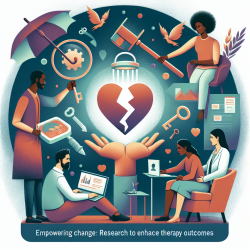Introduction
As practitioners in the field of speech-language pathology, we are constantly seeking ways to enhance our therapeutic approaches and outcomes. A recent study titled The Role of Pornography Use in Intimate Partner Violence in Different-Sex Couples: A Prospective Longitudinal Study offers valuable insights that could inform our practice. This blog aims to dissect the findings of this study and explore how we can leverage this information to improve our services, particularly in the context of online therapy provided by companies like TinyEYE.
Understanding the Research
The study investigated the relationship between pornography use and intimate partner violence (IPV) in different-sex couples over a four-month period. The researchers found that frequent pornography use among men predicted an increase in IPV perpetration and victimization for both partners. Interestingly, women's pornography use did not predict changes in IPV, possibly due to lower usage rates compared to men.
This finding suggests that male pornography use could be an under-recognized risk factor for IPV, highlighting the need for further research to uncover underlying factors contributing to this relationship.
Implications for Practitioners
For practitioners, these findings underscore the importance of considering external factors, such as media consumption, when assessing and treating clients. Here are some practical steps to incorporate these insights into your practice:
- Screen for Media Consumption: Incorporate questions about media consumption, including pornography use, into your initial assessments to identify potential risk factors for IPV.
- Educate Clients: Provide educational resources to clients and their families about the potential impacts of media consumption on behavior and relationships.
- Collaborate with Other Professionals: Work with psychologists and other mental health professionals to address underlying issues related to media consumption and IPV.
- Encourage Further Research: Stay informed about the latest research in this area and consider participating in studies that explore the intersection of media consumption and therapy outcomes.
Encouraging Further Research
The study's findings highlight the need for continued research into the effects of media consumption on behavior and relationships. As practitioners, we can contribute to this body of knowledge by documenting our observations and outcomes, participating in research studies, and advocating for research funding in this area.
Conclusion
Incorporating research findings into our practice is crucial for improving therapy outcomes. By understanding the potential impact of pornography use on IPV, we can better support our clients and contribute to a safer, healthier environment for children and families. Let's continue to embrace data-driven decisions and strive for excellence in our field.
To read the original research paper, please follow this link: The Role of Pornography Use in Intimate Partner Violence in Different-Sex Couples: A Prospective Longitudinal Study.










